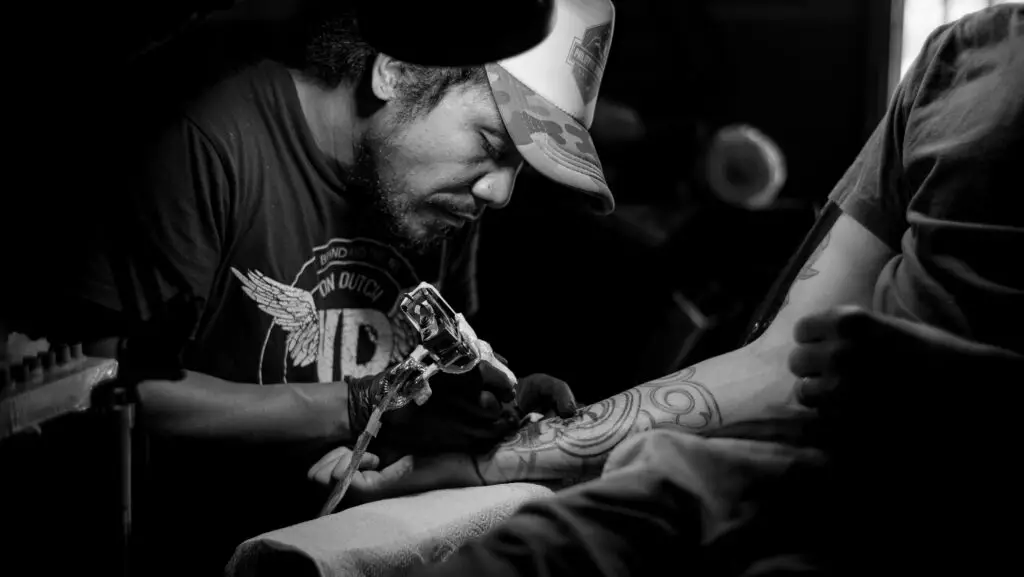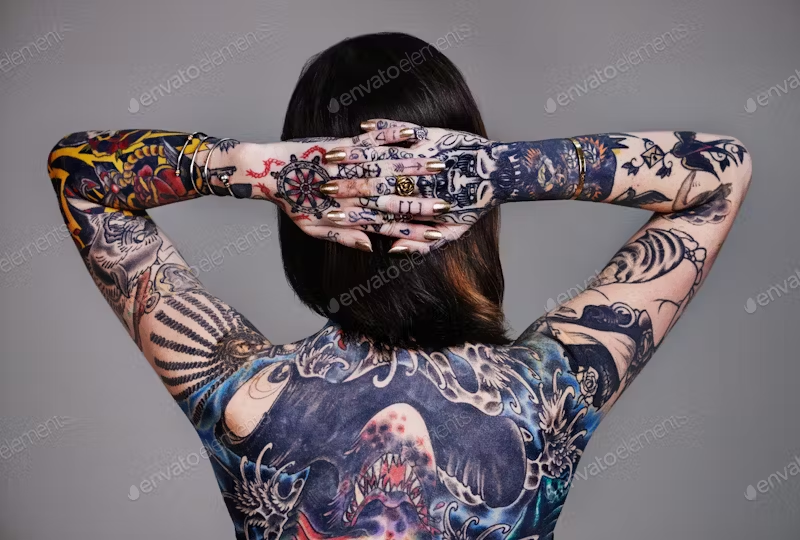Traditional tattoos, rooted in cultural symbolism and artistic heritage, have witnessed a remarkable resurgence in recent times. As timeless expressions of identity, these tattoos serve as a testament to the rich tapestry of human history. What makes this resurgence particularly intriguing is the growing popularity of traditional tattoos on dark skin, revealing a shift towards inclusivity and a celebration of diverse beauty.
Definition of Traditional Tattoos:
Traditional tattoos encompass a broad category of body art deeply entrenched in cultural symbolism and historical significance. Typically characterized by bold lines, vibrant colors, and iconic symbols, these tattoos draw inspiration from various traditional art forms, representing a visual narrative of cultural heritage.

Rise of Traditional Tattoos on Dark Skin:
In the evolving landscape of body art, the resurgence of traditional tattoos on dark skin stands out as a notable trend. As individuals from diverse backgrounds reclaim their cultural narratives, traditional tattoo styles find a new canvas on darker tones. This shift challenges conventional norms, fostering an appreciation for the unique vibrancy and aesthetic possibilities that dark skin offers to traditional tattooing.
Contents
The Artistry of Traditional Tattoos on Dark Skin
Understanding the Canvas: Dark Skin Tones
The Rich Palette of Dark Skin:
Dark skin tones provide a captivating and dynamic canvas for traditional tattoos. The inherent richness of melanin not only enhances the visual appeal of inked designs but also contributes to a distinctive aesthetic. The deep, natural tones of dark skin offer a unique backdrop that can elevate traditional tattoo artistry to new heights.
Challenges and Opportunities in Tattooing Dark Skin:
Tattooing on dark skin poses both challenges and exciting opportunities. The intricate details and vibrant colors inherent in traditional tattoos may require careful consideration to ensure clarity and longevity. However, the challenges are met with the prospect of creating visually striking designs that seamlessly meld with the natural hues of dark skin, resulting in a harmonious and impactful outcome.
Color Selection for Maximum Impact
Bold and Vibrant Hues:
When it comes to traditional tattoos on dark skin, the selection of colors plays a pivotal role. Opting for bold and vibrant hues is essential to ensure the design stands out prominently. Reds, yellows, oranges, and other intense colors not only create a visually stunning contrast but also contribute to the overall impact of the tattoo on dark skin.
Complementing Natural Undertones:
Harmonizing with the natural undertones of dark skin is a key consideration in color selection. A skilled artist understands how to complement these undertones, ensuring that the chosen colors not only pop but also integrate seamlessly with the individual’s unique skin tone, enhancing the overall visual appeal.
The Role of Skilled Artists
Importance of Artist Expertise:
The success of traditional tattoos on dark skin hinges on the expertise of the tattoo artist. Understanding the nuances of working with different skin tones is crucial. A skilled artist appreciates the complexities involved and can adapt traditional designs to suit dark skin, ensuring that the final result is not only visually striking but also respects the individuality of the canvas.
Customization for Individual Tones
Adapting Traditional Designs
Embracing Diversity in Dark Skin Tones:
The beauty of traditional tattoos lies in their adaptability to diverse skin tones. Embracing the spectrum of dark skin tones, artists can skillfully adapt traditional designs to celebrate the unique richness and nuances present in each individual. This adaptation ensures that the tattoo not only resonates visually but also culturally, creating a harmonious blend between the artistry and the canvas.
Personalization for Cultural Relevance:
Traditional tattoos on dark skin offer a powerful platform for personal expression and cultural celebration. By customizing designs to reflect individual stories, experiences, and cultural heritage, the tattoo becomes a deeply personal and meaningful representation. This emphasis on personalization ensures that the tattoo is not merely an art form but a profound expression of identity.

Avoiding Pitfalls: Light Colors on Dark Skin
Challenges with Lighter Colors:
While the allure of lighter colors is undeniable, they pose specific challenges on dark skin. Lighter pigments may not achieve the same visibility and vibrancy, potentially compromising the clarity of the tattoo over time. Understanding these challenges is essential in making informed decisions during the design phase.
Optimal Color Choices for Visibility:
Optimal color choices play a pivotal role in ensuring the visibility and longevity of traditional tattoos on dark skin. Darker and more saturated hues, such as rich reds, deep blues, and vibrant greens, are preferable for maintaining clarity. By avoiding lighter colors that may fade or blend into the natural pigmentation of the skin, individuals can ensure that their tattoos remain vivid and visually striking for years to come.
Size and Detail Considerations
Bold Lines and Intricate Details
Maintaining Clarity on Dark Skin:
The inherent richness of dark skin tones offers a stunning backdrop for traditional tattoos, but maintaining clarity in intricate details is crucial. Bold lines become a cornerstone for preserving the integrity of the design, ensuring that each element remains distinct and visually impactful. The challenge lies in balancing complexity with legibility on the textured canvas of dark skin.
Sizing Strategies for Visual Impact:
The size of a traditional tattoo on dark skin is a strategic consideration for achieving visual impact. Enlarging the design slightly can be an effective approach, allowing for the preservation of intricate details without compromising clarity. A larger canvas provides the necessary space for the bold lines and vibrant colors to shine, contributing to an overall visually striking and harmonious composition.
Preliminary Steps
Importance of Color Tests:
Before embarking on the permanent journey of a traditional tattoo on dark skin, color testing emerges as a crucial preliminary step. This process is instrumental in ensuring that the selected hues interact harmoniously with the individual’s unique skin tone. By conducting color tests, potential issues are identified early, contributing to the longevity and vibrancy of the final tattoo.
The Testing Process:
Color testing involves applying small patches of the chosen pigments to a less visible part of the skin. This allows the tattoo artist and the individual to observe how the colors interact with the specific undertones of dark skin. The testing process provides valuable insights into how the final tattoo will appear, guiding decisions on color adjustments and ensuring a more accurate representation of the intended design.
Fine-Tuning the Color Palette:
Based on the observations from the color tests, the artist can fine-tune the color palette to achieve optimal results. This may involve adjusting the saturation, experimenting with different shades, or revisiting the overall color composition. Fine-tuning ensures that the chosen colors not only pop against dark skin but also align with the individual’s unique undertones, contributing to a vibrant and personalized tattoo that stands the test of time.
Traditional tattoos on dark skin
Traditional tattoos on dark skin redefine self-expression, blending vibrant hues and bold lines with the rich palette of diverse skin tones. More than mere adornments, these tattoos become personal narratives, weaving cultural roots and individual stories. As a powerful form of self-expression, they empower individuals to embrace their identity proudly.

In the fusion of traditional artistry and dark skin, a celebration of diverse beauty unfolds. This body art becomes a living canvas, showcasing the beauty found in cultural diversity. Traditional tattoos on dark skin are not just designs; they are a testament to the unity of global body art, contributing to a rich and inclusive narrative of individuality and expression.
When can I put a ring in my labret piercing
How Can I Hide My Helix? Incredible Facts About Piercings 2023




